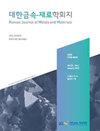基于晶界形式超薄银和 IZO 层的柔性透明导电电极的研究
IF 1.4
4区 材料科学
Q4 MATERIALS SCIENCE, MULTIDISCIPLINARY
引用次数: 0
摘要
本文研究了一种透明导电电极 (TCE),它通过在 PET 基材上沉积超薄的银金属,以随机晶界的形式形成氧化铟锌 (IZO) 层,从而满足了电气、光学和机械性能的要求。常用的 ITO 电极较脆,难以应用于柔性设备。相比之下,基于 IZO 的电极具有机械柔韧性,可用作柔性 TCE,并具有较高的电气和光学性能。厚度为 90 纳米的 IZO 电极在波长为 460 纳米时的透射率为 90.2%,片电阻为 29.5 欧姆/平方厘米。特别是,使用射频磁控溅射系统以非典型金属岛的形式沉积了银金属。在 3 nm 厚度时,金属岛形式的金属簇很少,形成了许多空隙通道,导致片电阻很高,透光率下降。然而,厚度约为 5 纳米时,空隙通道数量减少,光路发生变化,从而改善了电学和光学特性。结果显示,薄片电阻降低到 19.8 欧姆/平方英寸,透光率也提高到 91.1%。此外,还发现传统 IZO 和 Ag/IZO TCE 的机械性能相同。本文章由计算机程序翻译,如有差异,请以英文原文为准。
Research on Flexible Transparent Conductive Electrodes Based on Ultra-Thin Ag in the Form of Grain Boundary with IZO Layer
In this paper, we investigated a transparent conductive electrode (TCE) that satisfies electrical, optical, and mechanical properties, formed by depositing ultra-thin Ag metal in the form of a random grain boundary with an indium zinc oxide (IZO) layer on a PET substrate. Commonly used ITO electrodes are brittle and difficult to apply to flexible devices. In contrast, IZO-based electrodes are mechanically flexible and can be used as flexible TCE, and have high electrical and optical properties. A 90 nm thick IZO electrode has a transmittance of 90.2% at a wavelength of 460 nm and a sheet resistance of 29.5 ohm/sq. In particular, Ag metal was deposited in the form of an atypical metal island using an RF magnetron sputtering system. At 3 nm there were few metal clusters in the form of islands, and many void channels were formed, resulting in high sheet resistance as well as a decrease in optical transmittance. However, about 5 nm thickness, the number of void channels decreased and the optical path changed, improving the electrical and optical properties. Results showed that the sheet resistance was reduced to 19.8 ohm/sq, and the transmittance was also increased to 91.1%. The mechanical properties were also found to be the same for conventional IZO and Ag/IZO TCE.
求助全文
通过发布文献求助,成功后即可免费获取论文全文。
去求助
来源期刊

Korean Journal of Metals and Materials
MATERIALS SCIENCE, MULTIDISCIPLINARY-METALLURGY & METALLURGICAL ENGINEERING
CiteScore
1.80
自引率
58.30%
发文量
100
审稿时长
4-8 weeks
期刊介绍:
The Korean Journal of Metals and Materials is a representative Korean-language journal of the Korean Institute of Metals and Materials (KIM); it publishes domestic and foreign academic papers related to metals and materials, in abroad range of fields from metals and materials to nano-materials, biomaterials, functional materials, energy materials, and new materials, and its official ISO designation is Korean J. Met. Mater.
 求助内容:
求助内容: 应助结果提醒方式:
应助结果提醒方式:


